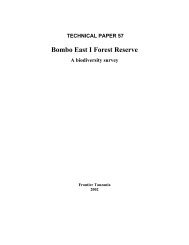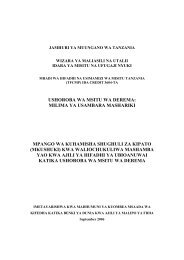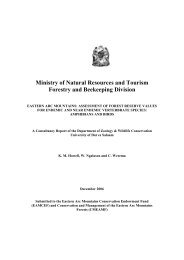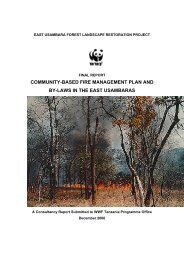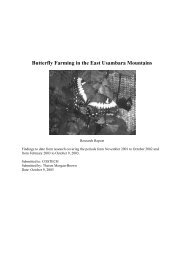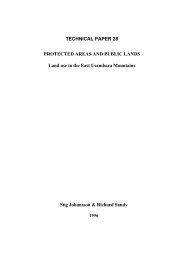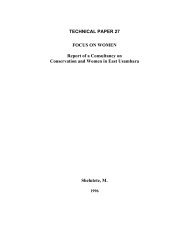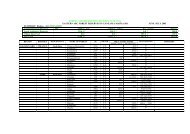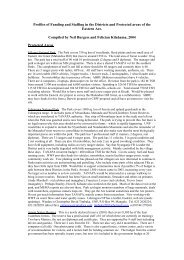Mgambo Forest Reserve: A biodiversity survey. - Eastern Arc ...
Mgambo Forest Reserve: A biodiversity survey. - Eastern Arc ...
Mgambo Forest Reserve: A biodiversity survey. - Eastern Arc ...
You also want an ePaper? Increase the reach of your titles
YUMPU automatically turns print PDFs into web optimized ePapers that Google loves.
<strong>Mgambo</strong> <strong>Forest</strong> <strong>Reserve</strong><br />
Two bird species observed in <strong>Mgambo</strong> FR were of restricted range and are summarised in Table<br />
27.<br />
Table 27 Restricted ranges of near endemic birds<br />
(1º source: Statterfield et al (1998), 2º Mlingwa et al. 2000), 3º: source: UDSM (1997).)<br />
Species name Common name Range<br />
Campethera mombassica Mombasa Woodpecker East Usambara Mountains and Coastal forests<br />
north of Tanga from Shimba NP to Boni <strong>Forest</strong>.<br />
Tauraco fischeri Fischer’s Tauraco Endemic to Tanzania, Kenya, Coastal forest<br />
endemic.<br />
Apart from those birds that are of obvious importance in terms of threat status and retricted range,<br />
such as Tauraco fischeri (Fischer’s tauraco) which has been used to define one of the Birdlife<br />
International Endemic Bird Areas, there were a number of birds that were interesting because they<br />
are locally common and have a restricted and patchy distribution in East Africa. These include:<br />
Lonchura fringilloides (Magpie mannikin), commonly known from Amani; Tauraco<br />
porphyreolophus chlorochlamys (Purple-crested turaco), with no recent records in north Tanzania<br />
(Zimmerman et al 1996); and Onychognathus morio (Red-winged starling), known to be rare in<br />
the Usambara foothills.<br />
Bycanistes brevis (Silvery cheeked hornbill), Bycanistes bucinator (Trumpeter hornbill) and<br />
Stactolamema leucotis kilimensis (White-eared barbet) are common but fairly restricted to North<br />
<strong>Eastern</strong> Tanzania and Southern Kenya.<br />
Also of interest was Ispinina picta natalensis (African pygmy kingfisher), a non-breeding migrant<br />
species from South Africa, present in Coastal forests from April to September, and Cossypha<br />
natalensis (Red-capped Robin-chat), an Afrotropical migrant.<br />
It is also important to consider the birds species that have not been found in <strong>Mgambo</strong> forest<br />
reserve, such as the lowland species: Sokoke scops owl, Otus ireneae; the endemic Usambara<br />
eagle owl, Bubo vosseleri; Swynnerton’s robin, Swynnertonia swynnertoni; East coast akalat,<br />
Sheppardia gunningi; Amani sunbird, Anthreptes pallidigasterthe Banded green sunbird,<br />
Anthreptes rubritorques and the near-threatened Southern banded snake eagle (Circaetus<br />
fasciolatus). <strong>Forest</strong> dependent species, such as Burr-spotted fluff tail (Sarothrura elegans), Barred<br />
long-tailed cuckoo (Cercococcyx montanus) and the <strong>Forest</strong> batis (Batis mixta), are known from<br />
wetter and more intact lowland forest areas of the East Usambaras. Therefore, this preliminary<br />
bird species list may suggest that <strong>Mgambo</strong> is too dry and fragmented for many typical lowland<br />
coastal forest species.<br />
5.4.3 Reptiles<br />
A total of 45 reptile individuals representing 20 species and 9 families were captured in <strong>Mgambo</strong><br />
FR during 1320 pitfall trapping nights and opportunistic collection. These species are summarised<br />
in Table 28. At least one individual representing each species were taken as specimens for<br />
taxonomic purposes and await formal identification. Nomenclature follows Spawls et al (2002).<br />
East Usambara Conservation Area Management Programme Technical Paper 59<br />
56



